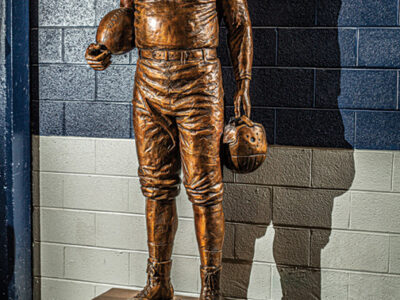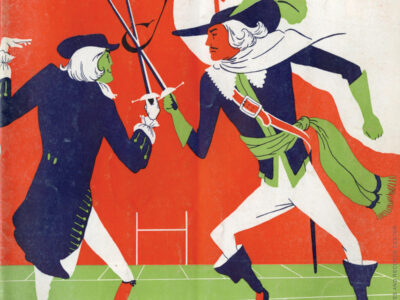The difference three decades makes, in cars and camps.
By Robert G. DeSantis
EXITING THE SCHUYLKILL EXPRESSWAY onto South Street to pay a visit to this year’s Penn summer football camp, I thought back to the times I had been down this road 30 years before, when I was on the team. I had gotten the idea of attending the camp during a fishing trip with this year’s co-captain, Jim Finn, to satisfy my curiosity as to the differences in camp today versus my last camp in 1968. The neighborhood looked the same. Franklin Field still loomed on the horizon, as intimidating as ever, and I could smell the fried onions from those great Philly cheesesteaks in the air (or maybe it was the fumes from the oil refineries). But that’s where the similarities ended.
Comparing Penn football 1998 to 1968 is a bit like comparing the car I drive now — a 1998 Volkswagen Beetle — with the one I drove then — a 1961 VW. First is the difference in size. Penn’s current offensive line averages 278 pounds vs. 235 pounds in 1968. The three strongest “kids” on the team are the three down-linemen on defense, and I’m sure they could bench-press either model VW. Not only are today’s players taller, heavier, and stronger, but, just like my new VW, they are faster and more agile. Finn, a fullback, runs the 40 yard dash in 4.4 seconds, and weighs 243 pounds.
My new VW has cruise control, power windows, automatic door locks, a security system, tape deck, AM/FM radio, CD player, and a power trunk release. That’s a lot of equipment compared to the old VW’s six knobs — two for tuning and volume control on the radio, and one each for reserve gas, the floor heater, lights, and windshield wipers.
Today’s football equipment includes helmets with linings that can be inflated for fit; spinning tire wheels that rifle perfect spirals, for practicing punt returns and developing soft hands for the ends; and fancy rehabilitation equipment you can take to bed with you to help promote healing. A new locker room, relocated to the eastern end of Franklin Field, features air-conditioning, wall-to-wall red-and-blue carpet, and a weight room with pictures of past Ivy League championship teams on the walls. Every practice is videotaped (in the old days, only games were filmed), so that coaches can review performance each evening and use the video as a teaching tool. The technology has advanced, but the coaches still use expressions like, “Do you know what full speed means?” and “Go to the ball!”
We had orange pullovers to distinguish between offense and defense, while today the offense is in white, the defense blue, quarterbacks in red, and kickers in yellow. The world of specialization has definitely arrived, with little or no crossover among jobs. Although it was already becoming rare in 1969, some athletes played more than one position — and sometimes more than one sport. This is practically unheard of now. Many players told me they picked their sport by the sophomore year of high school to be competitive.
It’s hard to imagine, but there is little or no calisthenics at football camp these days. Today’s players are expected to do more on their own to get in shape and stay in shape. “Cals” have been replaced by lots more stretching of the muscles before and after practice: Stretching, form running, and skipping help reduce injuries and avoid muscle cramps. Some drills look more like ballet exercises, but they improve balance, agility, and athleticism.
Today’s players are intelligent, committed, and a bit more analytical than we might have been. They work harder and longer than we ever did and seem to have less time for social life. Once classes begin, the team meets every Tuesday, Wednesday, and Thursday at 7:30 A.M. to review films and discuss strategies for the upcoming game. We would still have been in bed!
As I drove past the practice field on my way back to South Florida, I thought how proud I am to be a Penn alumnus and to have been part of the team Newsweek called the worst team in the East in 1968 and which ended up 7-2. I reflected on how fortunate I was to have been able to spend some time with the 1998 squad, and how impressive they were — not just as a football team but a very special group of hard-working, dedicated kids. Finally, I thought how fortunate the University is to have Coach Al Bagnoli and the committed professionals he has put at every position.
I think the world of today’s players and coaches, but there were two things I was especially glad about … first, that I went to camp in 1968 and not 1998 and, second, that my VW was a 1998 and not a 1961 as I crossed the Walt Whitman Bridge, heading home.
Robert G. DeSantis, W’69, president of DeSantis Commercial, Inc., captained his freshman football team and started at middle linebacker in his sophomore, junior, and senior years. He lives in Sewall’s Point, Fla.




